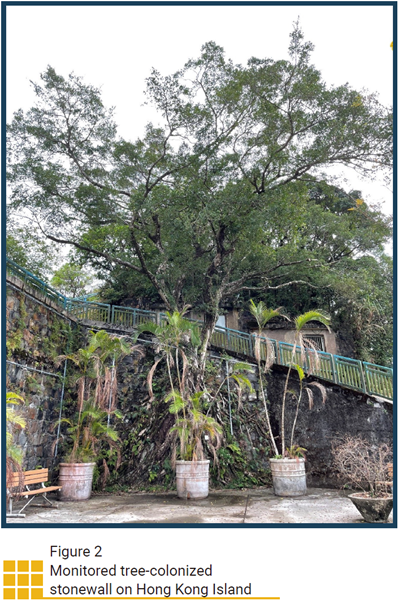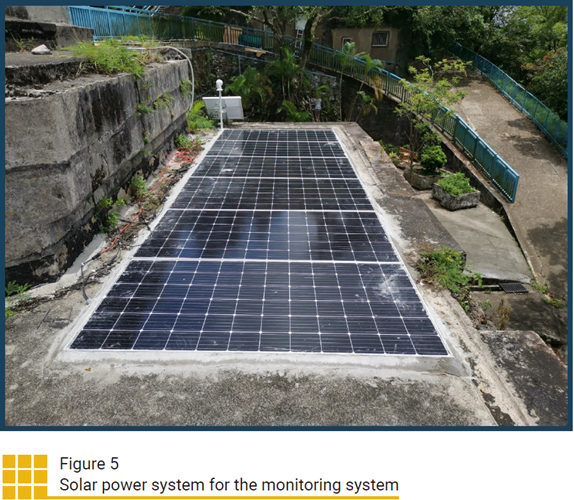Research Excellence

Newsletter Apr 2021
For other issues, please visit here.
A smart system for automatic monitoring and early risk warning of dynamic deflections and possible failures of masonry retaining and large trees
Masonry retaining walls were built in Hong Kong to provide horizontal platforms and stabilise man-made slopes since 1840s. Trees growing on the masonry walls are identified as stonewall trees. Such unique tree-wall structures have high ecological and cultural values (see Figures 1 and 2). Typhoons have caused widespread damages to Hong Kong including breaking countless trees. In 2018, typhoon Mangkhut, activating the highest tier No. 10 warning signal, caused numerous tree collapse incidents. Refer to DEVB (2018), over 60 800 tree failure reports were received. Among those tree failures, 11 of them were registered as old and valuable trees. To protect the historical trees and unique tree-wall structures, Professor Jian-Hua YIN’s team of the CEE department has developed a self-powered smart system for automatic monitoring and early risk warning of dynamic deflections and possible failures of masonry retaining walls, stonewall trees, and large trees. Dr Dao-Yuan TAN, Dr Wen-Bo CHEN and Mr Pei-Chen WU, as key members of the project team, are actively involved in development of this system. By collaborating with the Works Branch of Development Bureau (DEVB) of HKSARG of China, Three such automatic monitoring systems were installed in three remote sites on Hong Kong Island to monitor the movement of masonry retaining walls and the deflection of stonewall trees using the advanced optical fiber sensing technology.

Optical fiber sensing technology is gaining lots of appreciation and acceptance in structural health monitoring (SHM), as it is suitable for accurate measurement of strain and long-term monitoring of structures. The first fiber Bragg grating (FBG) was invented by Hill et al. (1978). Since then, FBG sensing technology has become the most widely used optical fiber sensing technology for strain and temperature measurement. Capacity of multiplexing is a prominent merit of fiber Bragg grating (FBG) sensing technology, which allows many sensors connected in series for measurement of various parameters. Besides, immunity to electromagnetic interference, high accuracy, and good reliability are its favoured advantages. Therefore, FBG sensing technology is a promising technology for monitoring masonry retaining walls, stonewall trees, and large trees, which may be at risks or subjected to failure when exposed to severe weather such as typhoon or strong wind, heavy rain, increase of ground water or water pressure.

The monitoring system is composed of three major components, that is, active sensors installed in the site (see Figure 3), on-site data processing center, and monitoring service to customers. Figure 4 shows a flow chart of the monitoring system. As shown, signals of the transducers installed at a site are detected by the data acquisition system and transferred to the data processing system for data analysis. The dynamic movement of the masonry retaining wall and deflection of the trees are visualized by analysing the real-time data of the transducers. If the deflection of a tree or the deformation of a masonry retaining wall exceeds the pre-set threshold, warning or alarming messages will be sent to the pre-assigned email distribution list. Since no power supply can be provide in the remote areas, a solar power system was utilized as a sustainable solution for power supply to the monitoring system (see Figure 5).

Beside the current application for protecting the safety of historical trees and the tree-colonized masonry retaining walls, this system has great potential for further other applications in civil and geotechnical engineering, for example, life monitoring of important structures, slopes, debris flows, with smart early warning of possible failure of all these objects based on the deep analysis of dynamic reflections and Artificial Intelligence.

References
DEVB (2018). LCQ 20: Handling of fallen trees and broken branches. Retrieved from https://www.devb.gov.hk/en/publications_and_press_releases/press/index_id_10172.html. Development Bureau (DEVB) of The Government of the Hong Kong Special Administrative Region (HKSARG) of China.
Hill, KO, Fujii, Y, Johnson, DC, and Kawasaki, BS (1978). Photosensitivity on optical fiber waveguides:application to reflection filter fabrication. Applied Physics Letters 32 647–9.





